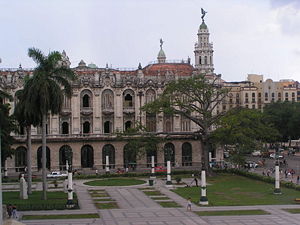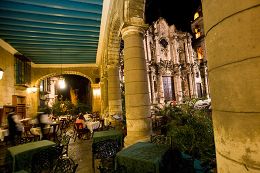Old Havana
| Old Havana and its Fortifications* | |
|---|---|
| UNESCO World Heritage Site | |

| |
| State Party | |
| Type | Cultural |
| Criteria | iv, v |
| Reference | 204 |
| Region** | Latin America and the Caribbean |
| Inscription history | |
| Inscription | 1982 (6th Session) |
| * Name as inscribed on World Heritage List. ** Region as classified by UNESCO. | |
Old Havana (Spanish: La Habana Vieja) contains the main area of the original city of Havana. The positions of the original Havana city walls are the modern boundary area of the Old Havana.
Old Havana is a UNESCO World Heritage Site and the name also refers to one of the municipalities of the city of Havana, Cuba, with the latter's boundaries extending to the south and west beyond the original city.
EB: "...a residential area. It is richly endowed with historic buildings, representing architectural styles from the 16th through the 19th century. Covering some three square miles and hugging the harbour, Old Havana includes Spanish colonial structures, towering Baroque churches, and buildings in Neoclassic style, as well as commercial property and less pretentious homes on the fringes."
History
Spain established the city of Havana in 1519, one of the first cities in the western hemisphere to be founded by Europeans. The history of Havana spans three basic periods: the Spanish colonial period from 1519 to 1898; the American neocolonial period from 1898 to 1959; and the revolutionary period which began in 1960. The urban landscape clearly reflects elements of each of these periods.
It was the during the nearly 400-year colonial period that the core of the city was built in the Spanish colonial style. Its distinguished architecture led to it being designated a UNESCO World Heritage Site in 1982.
Havana's first settlement was built on the western edge of Havana Bay. Regular attacks by buccaneers, pirates, and French corsairs caused the Spaniards to begin fortifying the city. Four imposing colonial forts constructed of coral-limestone flank Havana Bay. Two of these are at the entrance to the channel, on the north the Castillo del Morro (now a maritime museum) and on the south the Castillo de la Punta (now the Museum of Fortifications and Armaments).
HERE
Two other forts are sited on the channel: the massive Fortaleza de San Carlos de la Cabana on the north side, which now houses a museum of ceramic arts, and the Castillo de la Real Fuerza on the south side, which was undergoing restoration work in the late 1990s.
The original city focused on the central plaza, the Plaza de Armas. Focusing on a central plaza was a pattern of settlement typical of Spanish colonial cities, with important military, political, and religious buildings constructed within close proximity. The imposing colonial fort, Castillo de la Real Fuerza, lies adjacent to the plaza on the north. Other noteworthy landmarks are also built along the plaza, among them the Palacio de los Capitanes Generales, which served as the home of the colony's governors, then later as the presidential palace, the seat of the city's municipal government, and the city museum. The Palacio de Segundo Cabo, originally constructed as a colonial post office in 1772, also sits on the Plaza de Armas.
The Plaza del Catedral located just a few blocks from the Plaza de Armas represents another important focus in Old Havana. Havana's cathedral, known as either the Catedral de la Habana or the Catedral de la Concepción Inmaculada dominates the plaza with its unusual mismatched belfry towers.
The Plaza Vieja, established in 1584, represents another major historic landmark of Old Havana. However, in contrast to the other plazas, public and religious architecture are absent. Instead the palatial homes and mansions of the city's colonial elite flank its sides. Many of these buildings have fallen into disrepair, but several are in various stages of restoration. One, the Casa de los Condes de Jaruco, has been fully restored and stands as an excellent example of a late colonial mansion.
Like many colonial cities in coastal areas, the Spanish walled the city to protect it from attacks by pirates and foreign powers. Havana's walls were built from 1674 to 1797 and enclosed an area of about 3 sq km (about 1 sq mi). This area defined the extent of Old Havana. The city's walls were torn down in 1863 to accommodate the growing city. The narrow streets of the old city contain many buildings of historical and cultural significance, accounting for perhaps as many as one-third of the 3000 buildings found in Old Havana.
Havana Vieja was founded by the Spanish in 1519 in the harborside of the Bay of Havana. It became a stopping point for the treasure laden Spanish Galleons on the crossing between the New World and the Old World. In the 17th century it was one of the main ship-building centers. The city was built in baroque and neoclassic style. Many buildings have fallen in ruin in the later half of the 20th century, but a number are being restored. The narrow streets of old Havana contain many buildings, accounting for perhaps as many as one-third of the approximately 3,000 buildings found in Old Havana. It is the ancient city formed from the port, the official center and the Plaza de Armas. Old Havana was destroyed and burned by the French corsair Jacques de Sores. The pirate had taken Havana easily, plundering the city and burning much of it to the ground. After limiting the scarce defenders, De Sores left without obtaining the enormous wealth that he was hoping to find in Havana. The city remained devastated and set on fire. Since the incident, the Spanish brought soldiers and started building fortresses and walls to protect the city. Castillo de la Real Fuerza was the first fortress built; initiated in 1558, the construction conducted by the engineer Bartolomé Sanchez.
Old Havana resembles Cadiz and Tenerife. Alejo Carpentier called it "de las columnas"(of the columns), but it could also be named for the gateways, the revoco, the deterioration and the rescue, the intimacy, the shade, the cool, the courtyards... In her there are all the big ancient monuments, the forts, the convents and churches, the palaces, the alleys, the arcade, the human density. The Cuban State has undertaken enormous efforts to preserve and to restore Old Havana through the efforts of the Office of the Historian of the City, directed by Eusebio Leal.
Main sights
- Malecón is the avenue that runs along the seawall at the northern shore of Havana, from Habana Vieja to the Almendares River.
- Castillo del Morro, picturesque fortress guarding the entrance to Havana bay. The construction of the castle Los Tres Reyes del Morro owed to the step along in Havana of the English pirate Sir Francis Drake. The king of Spain arranged its construction on a big stone which was known by the name of El Morro. He sent the field master Juan de Texeda, accompanied of the military engineer Battista Antonelli, who came to Havana in 1587 and began the task at once.
- La Cabaña fortress, located on the east side of the Havana Bay. The most impressive fortress of the Spanish colony was La Cabaña. It impresses with its walls of the ends of the XVIIIth century constructed along with El Morro. Every night at 9 p.m., a few soldiers dressed in suits of the epoch shoot from her the “el cañonazo de las nueve”, (gunshot of the nine). It went off every day to warn of the closing of the doors of the wall that surrounded the inner part of the city.
- San Salvador de la Punta Fortress, In the shore opposite to the Castle of El Morro, at the beginning of the curve of El Malecon, there rises the fortress of San Salvador de la Punta, of minor architectural dimensions. It was constructed in 1590, and in 1629 the Chapter of Havana decided, to defend better the port, to join her in the night with the El Morro by using a thick chain that prevented the entry of enemy ships.
- Castillo de la Real Fuerza, The fortress or the Castle of the Royal Army is another big monument that closes the Plaza de las Armas. It was the first big fortification of the city, initiated in 1558 on the ruins of an ancient fortress. In the same year, the Crown sent to Cuba the engineer Bartolomé Sanchez, supervised by 14 official and main stonemasons in order to reconstruct the castle, which had been set fire and destroyed by the French corsair Jacques de Sores.
- Catedral de San Cristóbal, the most prominent building on the Plaza de la Catedral. The Cathedral was raised on the chapel after 1748 by order of the bishop from Salamanca, Jose Felipe de Trespalacios. It is one of the most beautiful and sober churches of the American baroque.
- National Capitol, styled after the Panthéon (Paris), looking similar to the U.S. Capitol[1].
- Galician Center, Central Park, The Galician Center, of neobarroque style was establish as a social club of the Galician emigrants between 1907 and 1914. Built on the Theater Tacon (nowadays Great Theater of Havana), it was open during the Carnival of 1838 with five masked dances.
- Plaza de Armas - the main touristic square. The origin of its name is military, since from the end of the XVIth century the ceremonies and the military events took place here.
- Gran Teatro de la Habana, the Great Theater of Havana is famous, particularly for the acclaimed National Ballet of Cuba and its founder Alicia Alonso. It sometimes performs the National Opera. The theater is also known as concert hall, Garcia Lorca, the biggest in Cuba.
- The Museum of the Revolution, located in the former Presidential Palace, with the boat Granma on display in front of the museum.
- San Francisco de la Habana Basilica, Habana Vieja, The set of church and convent of San Francisco de Asis, byline of the year 1608, and it was reconstructed in 1737.
UNESCO Heritage site
In 1982, La Habana Vieja was inscribed in the UNESCO World Heritage List.[2] A safeguarding campaign was launched a year later to restore the authentic character of the buildings.
Photo gallery
- Castillo del morro.jpg
El Morro Castle
- Sancristobalcathedral.jpg
San Cristóbal Cathedral
- TeatroGarciaLorca.jpg
Great Theater of Havana
Notes
- ↑ Frank Herbst, Cuba - Handbuch für individuelles Reisen, Reise Know-How Verlag 2006
- ↑ Habana Vieja - UNESCO World Heritage List
ReferencesISBN links support NWE through referral fees
- Harvey, David Alan. 1999. "The Rebirth of Old Havana - Renovation in the heart of Cuba's capital city illuminates centuries of architectural splendor". National Geographic. 195 (6): 36.
- Lobo Montalvo, María Luisa, Zoila Lapique Becali, and Alicia García Santana. 2000. Havana: history and architecture of a romantic city. [New York, N.Y.]: Monacelli Press. ISBN 9781580930529
- Sapieha, Nicolas, and Francesco Venturi. 1990. Old Havana, Cuba. Travel to landmarks. London: Tauris Parke Books. ISBN 9781850432210
- UNESCO World Heritage Centre. Old Havana and its Fortifications Retrieved December 2, 2008.
External links
| |||||||
Credits
New World Encyclopedia writers and editors rewrote and completed the Wikipedia article in accordance with New World Encyclopedia standards. This article abides by terms of the Creative Commons CC-by-sa 3.0 License (CC-by-sa), which may be used and disseminated with proper attribution. Credit is due under the terms of this license that can reference both the New World Encyclopedia contributors and the selfless volunteer contributors of the Wikimedia Foundation. To cite this article click here for a list of acceptable citing formats.The history of earlier contributions by wikipedians is accessible to researchers here:
The history of this article since it was imported to New World Encyclopedia:
Note: Some restrictions may apply to use of individual images which are separately licensed.



